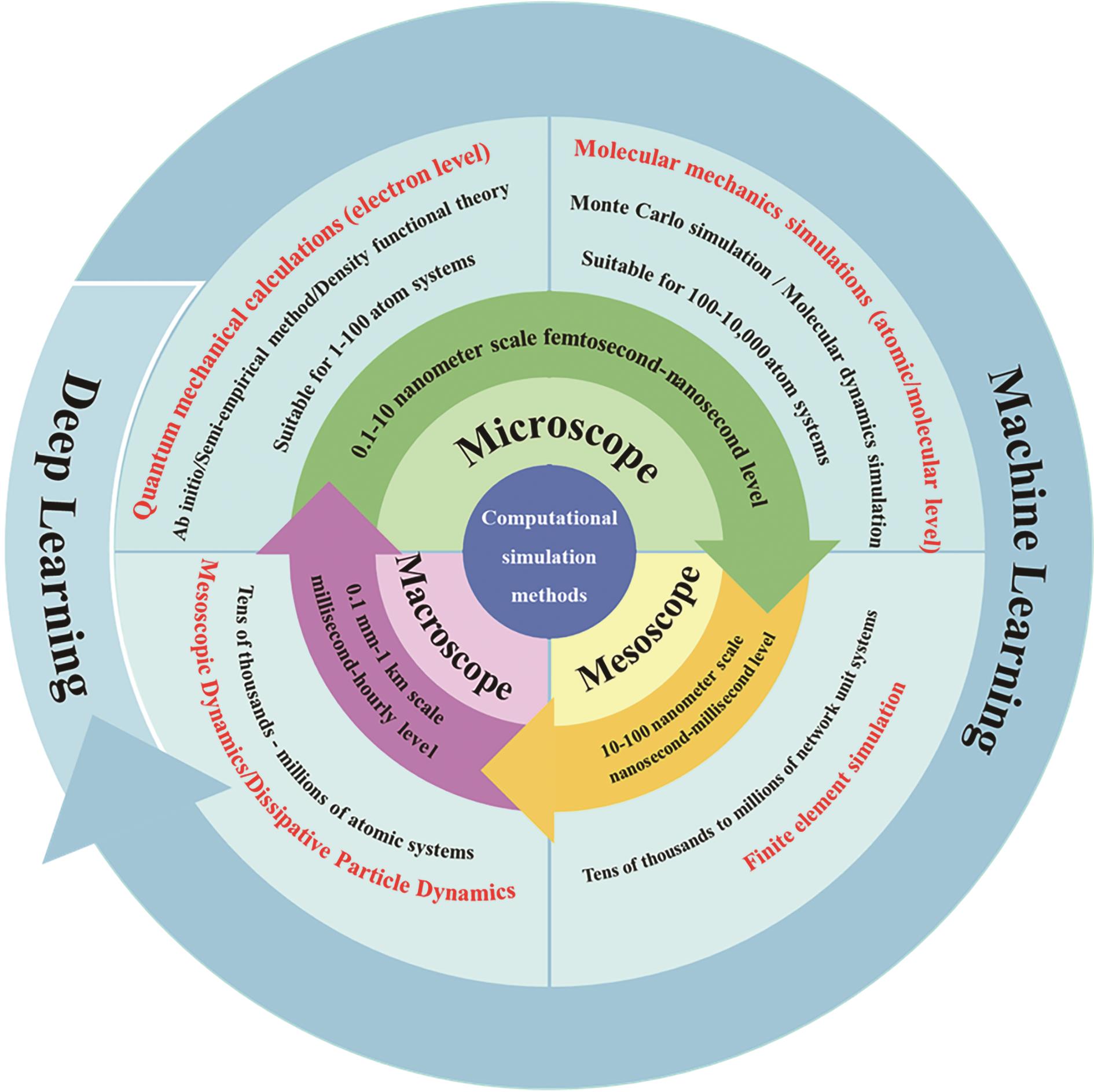
Chinese Journal of Applied Chemistry ›› 2023, Vol. 40 ›› Issue (12): 1643-1661.DOI: 10.19894/j.issn.1000-0518.230174
• Review • Previous Articles Next Articles
Research Progress of Computation and Simulation Application in the Study of Adsorption Mechanism and Design of Metal-Organic Frameworks Materials
Lei HUANG1,3, Qian-Wen YANG1,3, Jing-Ling ZHANG1,3, Fei XU1,3, Tai YE1,3, Xing-Fa REN2,3, Xiu-Xiu WU1,3( )
)
- 1.School of Health Science and Engineering,University of Shanghai for Science and Technology,Shanghai 200093,China
2.Welch Materials,Inc,Shanghai 201203,China
3.Shanghai Engineering Research Center of Food Rapid Detection,Shanghai 200093,China
-
Received:2023-06-12Accepted:2023-11-06Published:2023-12-01Online:2024-01-03 -
Contact:Xiu-Xiu WU -
About author:xiuxiuwu@usst.edu.cn
-
Supported by:the Program of Shanghai Academic/Technology Research Leader(22XD1434700);the National Natural Science Foundation of China(32302219)
CLC Number:
Cite this article
Lei HUANG, Qian-Wen YANG, Jing-Ling ZHANG, Fei XU, Tai YE, Xing-Fa REN, Xiu-Xiu WU. Research Progress of Computation and Simulation Application in the Study of Adsorption Mechanism and Design of Metal-Organic Frameworks Materials[J]. Chinese Journal of Applied Chemistry, 2023, 40(12): 1643-1661.
share this article
Add to citation manager EndNote|Ris|BibTeX
URL: http://yyhx.ciac.jl.cn/EN/10.19894/j.issn.1000-0518.230174
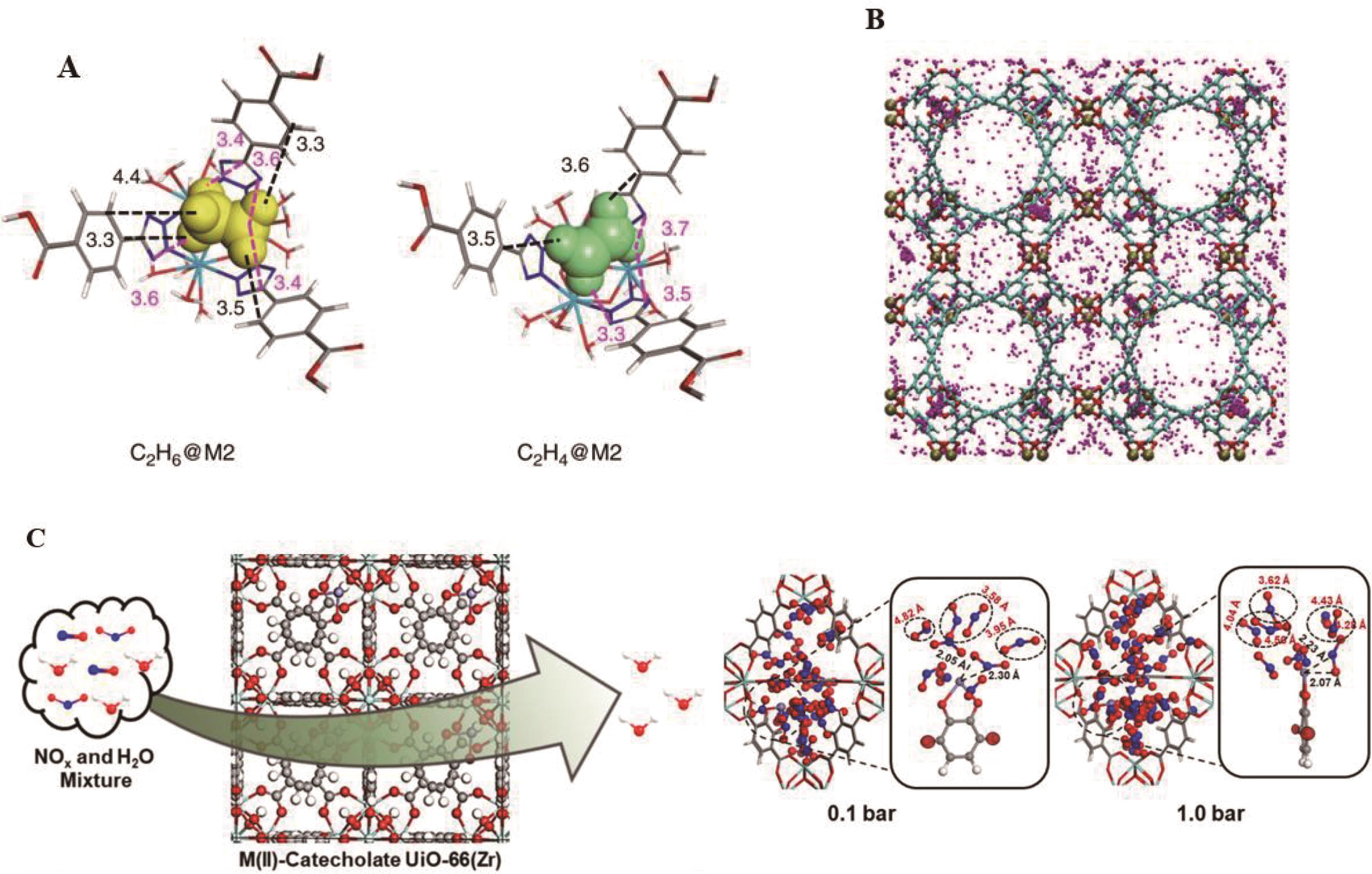
Fig.2 (A) Adsorption structures of C2H6 and C2H4 under the M2 model[59]; (B) Molecular view of H2 molecules adsorbed in the NU-111 cell[61]; (C) Adsorption model of NO2 and H2O mixture in UiO-66-CatM(?Ⅱ?) and GCMG simulation of NO2 adsorbed in UiO-66-CatFe(?Ⅱ?) at 0.1 and 1.0 bar snapshot[62]
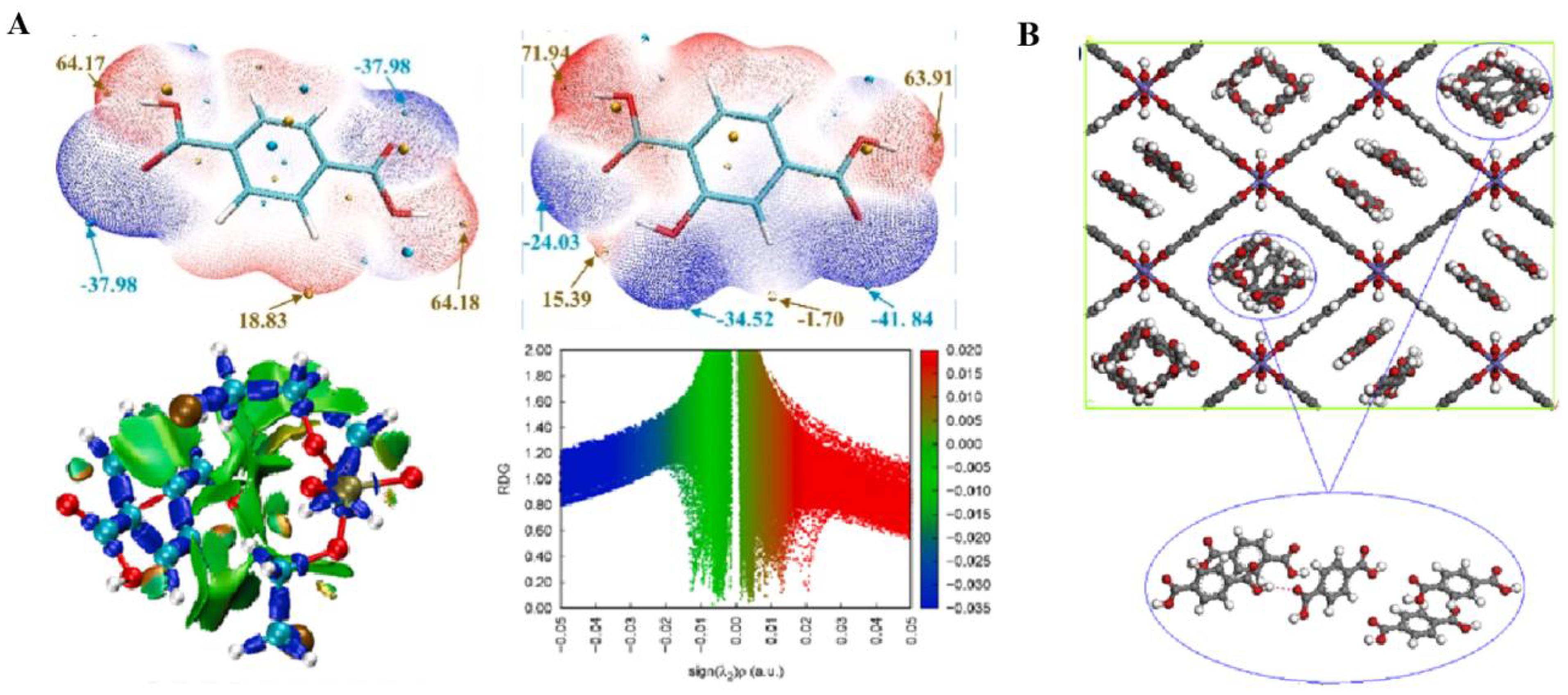
Fig.3 (A) Analysis of the adsorption mechanism of BDC and TCEP by ESP distribution, IRI contour surface plot and RDG scatter plot[70]; (B) Schematic diagram of TPA molecules adsorbed by MIL-53(V)[72]
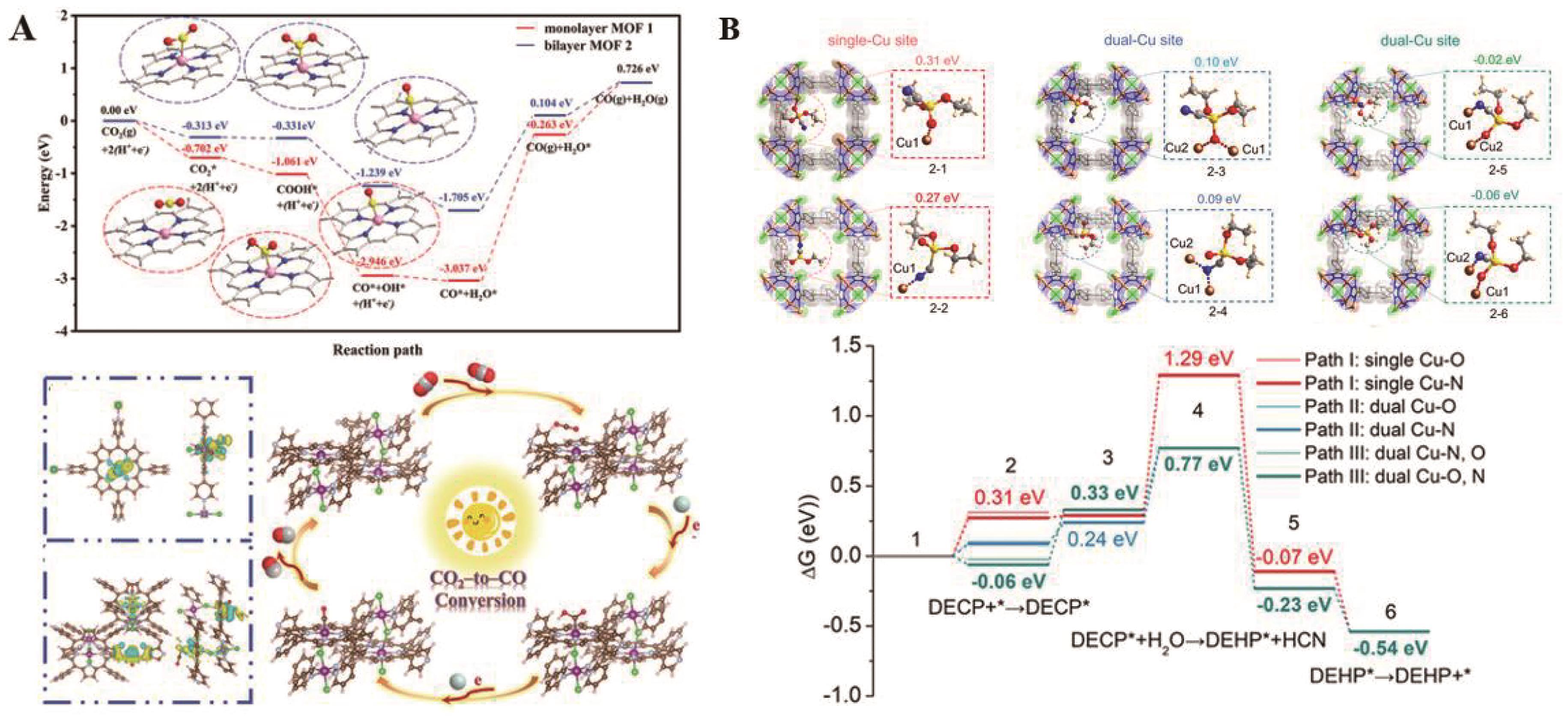
Fig.4 (A) Calculated free energy diagrams of CO2 reduction reactions of monolayer MOF-1 and bilayer MOF-2, charge density of CO2 and intermediates, and DFT simulation process of CO2 to CO conversion (with bilayer MOF-2 as an example)[75]; (B) Calculation of six DECP adsorption sites on ZZU-282 and free energy diagrams of the DECP hydrolysis pathway catalyzed by ZZU-282[76]
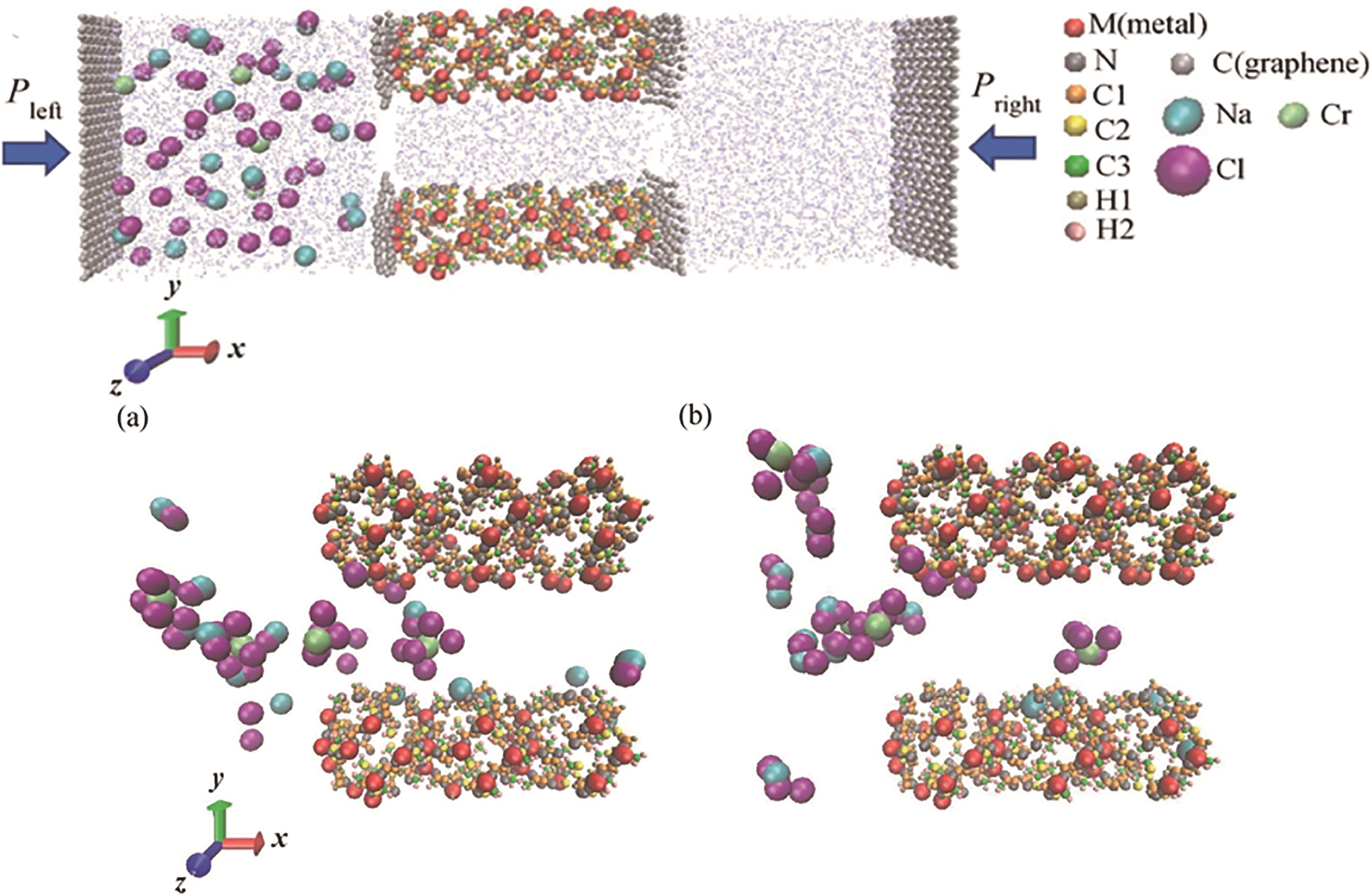
Fig.5 Schematic of the simulated system for ZIF-67 desalinated seawater and snapshots of the ZIF-67 CDI system with NaCl and CrCl6 salts at the end of the simulation[80]: (a) without and (b) with external electric field
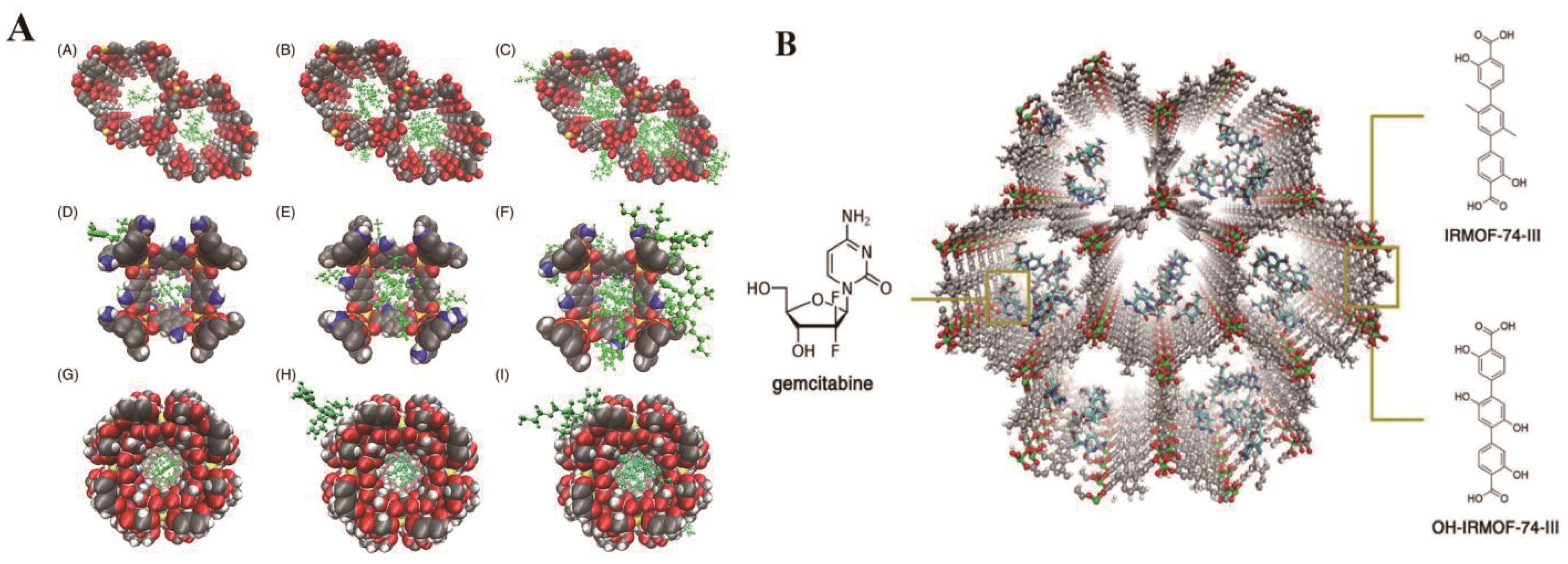
Fig.6 (A) Snapshots of amlodipine in three MOFs at different uptakes, IRMOF-74-Ⅲ: (a) 61 mg/g, (b) 195 mg/g and (c) 390 mg/g; IRMOF-3: (d) 189 mg/g, (e) 315 mg/g and (f) 629 mg/g; CDMOF-1: (g) 24 mg/g, (h) 61 mg/g and (i) 122 mg/g[86] ; (B) Simulated view of MOF cells loaded with 32% (mass percent) GEM[87]
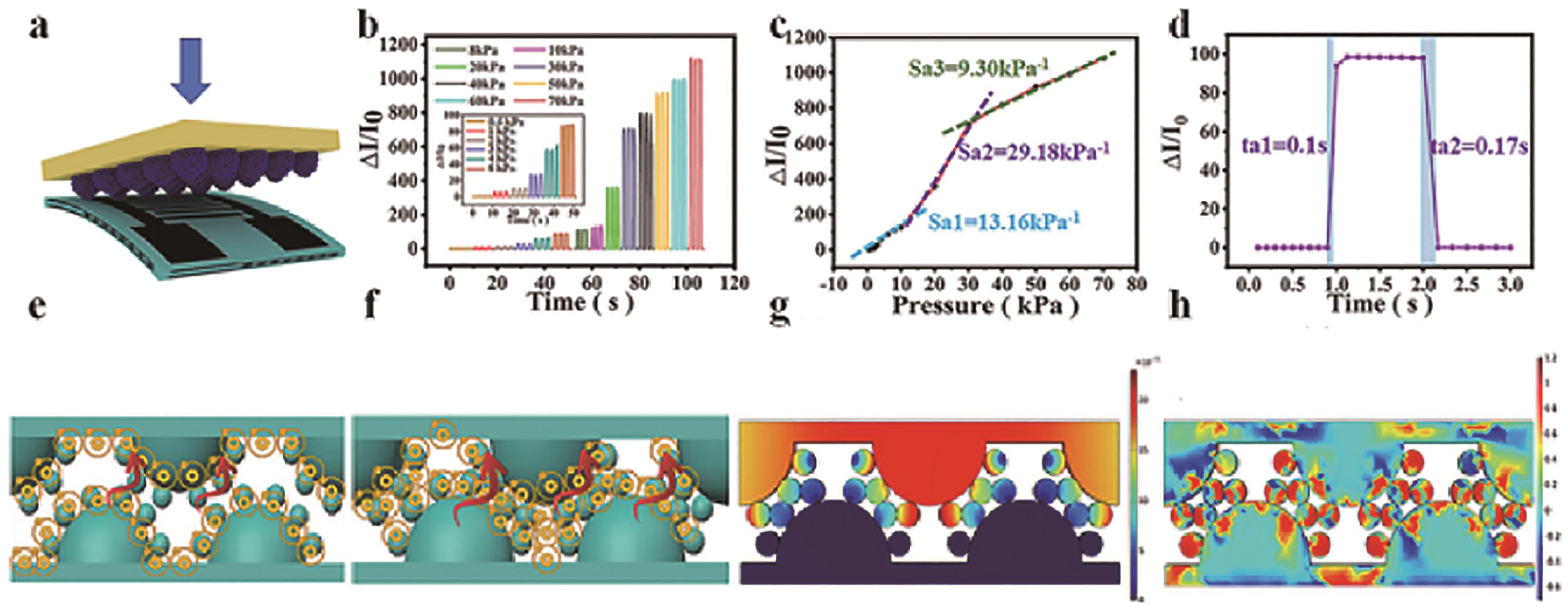
Fig.7 (a) Sensing performance of the cZIF-67@Cu-CAT based pressure sensor; (b) Repeated sensing response to different pressures under loading and unloading; (c) Sensing sensitivity of the pressure sensor in the range of 0.5~70 kPa; (d) Response/recovery time of the pressure sensor; (e, f) Schematic diagram of the pressure sensing mechanism with electronic transmission; (g, h) Pressure sensor receiving pressure: change in displacement and change in strain[91]

Fig.8 (A) High-throughput screening strategy for metal-organic backbones for hydrogen purification[98]; (B) MOF synthesis prediction implemented by machine learning models trained on the SynMOF-A database[100]; (C) Comparison of traditional experimental methods and machine learning strategies in predicting the structure of MOFs[100]
| 1 | GHANBARI T, ABNISA F, WAN DAUD W M A. A review on production of metal organic frameworks (MOF) for CO2 adsorption[J]. Sci Total Environ, 2020, 707: 135090. |
| 2 | ANNAMALAI J, MURUGAN P, GANAPATHY D, et al. Synthesis of various dimensional metal organic frameworks (MOFs) and their hybrid composites for emerging applications-a review[J]. Chemosphere, 2022, 298: 134184. |
| 3 | 汪杨, 李仕友, 伍随意, 等. 金属有机骨架材料对废水中铀的吸附研究综述[J]. 应用化工, 2022, 51(5): 1377-1382, 1388. |
| WANG Y, LI S Y, WU S Y, et al. A review on the adsorption of uranium from wastewater by metal-organic skeletal materials[J]. Appl Chem Ind. 2022, 51(5): 1377-1382, 1388. | |
| 4 | ABDOLLAHI N, MOUSSAVI G, GIANNAKIS S. A review of heavy metals' removal from aqueous matrices by metal-organic frameworks (MOFs): state-of-the art and recent advances[J]. J Environ Chem Eng, 2022, 10(3): 107394. |
| 5 | CASTAÑEDA A, JURADO M, MATZ O, et al. Hydrogen adsorption in metal-organic frameworks Cu-BTC and Fe-BTC: a comparative theoretical study[J]. J Phys: Conf Ser, 2019, 1221(1): 012016 |
| 6 | SUMER Z, KESKIN S. Molecular simulations of MOF adsorbents and membranes for noble gas separations[J]. Chem Eng Sci, 2017, 164: 108-121. |
| 7 | FLORES J G, SANCHEZ-GONZALEZ E, GUTIERREZ-ALEJANDRE A, et al. Greener synthesis of Cu-MOF-74 and its catalytic use for the generation of vanillin[J]. Dalton Trans, 2018, 47(13): 4639-4645. |
| 8 | FEREY G, SERRE C, MELLOT-DRAZNIEKS C, et al. A hybrid solid with giant pores prepared by a combination of targeted chemistry, simulation, and powder diffraction[J]. Angew Chem Int Ed Engl, 2004, 43(46): 6296-6301. |
| 9 | FÉREY G, MELLOT-DRAZNIEKS C, SERRE C, et al. A chromium terephthalate-based solid with unusually large pore volumes and surface area[J]. Science, 2005, 309(5743): 2040-2042. |
| 10 | MELLOT-DRAZNIEKS C, FÉREY G. Assembling molecular species into 3D frameworks: computational design and structure solution of hybrid materials[J]. Prog Solid State Chem, 2005, 33(2): 187-197. |
| 11 | MELLOT DRAZNIEKS C, NEWSAM J M, GORMAN A M, et al. De novo prediction of inorganic structures developed through automated assembly of secondary building units (AASBU method)[J]. Angew Chem Int Ed, 2000, 39(13): 2270-2275. |
| 12 | MAURIN G. Role of molecular simulations in the structure exploration of metal-organic frameworks: illustrations through recent advances in the field[J]. CR Chim, 2016, 19(1/2): 207-215. |
| 13 | SAVA GALLIS D F, VOGEL D J, VINCENT G A, et al. NOx adsorption and optical detection in rare earth metal-organic frameworks[J]. ACS Appl Mater Interfaces, 2019, 11(46): 43270-43277. |
| 14 | 刘利民. 材料基因工程:材料设计与模拟[J]. 新型工业化, 2015, 5(12): 71-88. |
| LIU L M. Materials genetic engineering: materials design and simulation[J]. J New Ind, 2015, 5(12): 71-88. | |
| 15 | KOHN W, BECKE A D, PARR R G. Density functional theory of electronic structure[J]. J Phys Chem, 1996, 100(31): 12974-12980. |
| 16 | RANKIN R B, LIU J, KULKARNI A D, et al. Adsorption and diffusion of light gases in ZIF-68 and ZIF-70: a simulation study[J]. J Phys Chem C, 2009, 113(39): 16906-16914. |
| 17 | DASH B, DASH B, RATH S S. A thorough understanding of the adsorption of Ni(Ⅱ), Cd(Ⅱ) and Zn(Ⅱ) on goethite using experiments and molecular dynamics simulation[J].Sep Purif Technol, 2020, 240: 116649. |
| 18 | CHONG S, LEE S, KIM B, et al. Applications of machine learning in metal-organic frameworks[J]. Coord Chem Rev, 2020, 423: 213487 |
| 19 | DEMIR H, DAGLAR H, GULBALKAN H C, et al. Recent advances in computational modeling of MOFs: from molecular simulations to machine learning[J]. Coord Chem Rev, 2023, 484: 215112. |
| 20 | ZANCA F, GLASBY L T, CHONG S, et al. Computational techniques for characterisation of electrically conductive MOFs: quantum calculations and machine learning approaches[J]. J Mater Chem C, 2021, 9(39): 13584-13599. |
| 21 | GUO S T, LIU J, QIAN W, et al. A review of quantum chemical methods for treating energetic molecules[J]. Energ Mater Front, 2021, 2(4): 292-305. |
| 22 | RUIPÉREZ F. Application of quantum chemical methods in polymer chemistry[J]. Intl Rev Phy Chem, 2019, 38(3/4): 343-403. |
| 23 | KHALID M Z, FRIIS J, NINIVE P H, et al. Ab-initio study of atomic structure and mechanical behaviour of Al/Fe intermetallic interfaces[J]. Comput Mater Sci, 2020, 174: 109481. |
| 24 | LIU B, LIU J, YANG J, et al. Ab initio thermodynamic optimization of Ni-rich Ni-Co-Mn oxide cathode coatings[J]. J Power Sources, 2020, 450: 227693. |
| 25 | ORUPATTUR N V, MUSHRIF S H, PRASAD V. Catalytic materials and chemistry development using a synergistic combination of machine learning and ab initio methods[J]. Comput Mater Sci, 2020, 174: 109474. |
| 26 | PARR R G. Density functional theory of atoms and molecules[J]. Horiz Quantum Chem, 1980: 5-15. |
| 27 | HOHENBERG P, KOHN W. Inhomogeneous electron gas[J]. Phys Rev, 1964, 136(3B): B864-B871. |
| 28 | KOHN W, SHAM L J. Self-consistent equations including exchange and correlation effects[J]. Phys Rev, 1965, 140(4A): A1133-A1138. |
| 29 | CAPITANI F, HÖPPNER M, JOSEPH B, et al. Combined experimental and computational study of the pressure dependence of the vibrational spectrum of solid picene C22H14[J]. Phys Rev B, 2013, 88(14): 144303. |
| 30 | PERDEW J P, BURKE K, ERNZERHOF M. Generalized gradient approximation made simple[J]. Phys Rev Lett, 1996, 77(18): 3865-3868. |
| 31 | 苏培峰, 谭凯, 吴安安, 等. 理论与计算化学研究进展[J]. 厦门大学学报(自然科学版), 2011, 50(2): 311-318. |
| SU P F, TAN K, WU A A, et al. Advances in theoretical and computational chemistry research[J]. J Xiamen Univ (Nat Sci), 2011, 50(2): 311-318. | |
| 32 | XIA P, WANG C, HE Q, et al. MOF-derived single-atom catalysts: the next frontier in advanced oxidation for water treatment[J]. Chem Eng J, 2023, 452: 139446. |
| 33 | 刘宇, 赵双良, 胡军, 等. 气体在金属-有机骨架材料中的吸附分离:经典密度泛函理论的应用[J]. 化工学报, 2016, 67(1): 89-96. |
| LIU Y, ZHAO S L, HU J, et al. Adsorption separation of gases in metal-organic skeletal materials: an application of classical density flooding theory[J]. CIESC J, 2016, 67(1): 89-96. | |
| 34 | STEELE W. Computer simulations of physical adsorption: a historical review[J]. Appl Surf Sci, 2002, 196(1): 3-12. |
| 35 | 刘睿, 陈曦. 聚合反应过程中的蒙特卡洛方法[J]. 高校化学工程学报, 2021, 35(3): 389-399. |
| LIU R, CHEN X. Monte carlo method in polymerization reaction process[J]. Chin J Chem Eng, 2021, 35(3): 389-399. | |
| 36 | BROOKS C L. Computer simulation of liquids[J]. J Solution Chem, 1989, 18(1): 99-99. |
| 37 | 赵素, 李金富, 周尧和. 分子动力学模拟及其在材料科学中的应用[J]. 材料导报, 2007(4): 5-8, 25. |
| ZHAO S, LI J F, ZHOU R H. Molecular dynamics simulation and its application in materials science[J]. Mater Rep, 2007(4): 5-8, 25. | |
| 38 | PARK J, RAMIREZ-HERNANDEZ A, THAPAR V, et al. Mesoscale simulations of polymer solution self-assembly: selection of model parameters within an implicit solvent approximation[J]. Polymers, 2021, 13(6): 953. |
| 39 | LIU F, ZHOU W, LIU D, et al. Coarse-grained molecular dynamics study on the rheological behaviors of surfactant aqueous solution[J]. J Mol Liq, 2018, 265: 572-577. |
| 40 | ELAHI S M, TAVAKOLI R, ROMERO I, et al. Grain growth competition during melt pool solidification-comparing phase-field and cellular automaton models[J]. Com Mat Sci, 2023, 216: 111882. |
| 41 | PI P, QIN D, LAN J L, et al. Dissipative particle dynamics simulation on the nanocomposite delivery system of quantum dots and poly(styrene-b-ethylene oxide) copolymer[J]. Ind Eng Chem Res, 2015, 54(23): 6123-6134. |
| 42 | SHARMA N K. Finite element modelling and simulations on effective thermal conductivity of particulate composites[J]. J Therm Anal Calorim, 2021, 147(4): 3441-3452. |
| 43 | LIU T. Finite element modeling of dynamic failure of composite laminates under transverse tensile loading[J]. J Fail Anal Preven, 2020, 21(1): 228-240. |
| 44 | TIAN X L, SONG S W, CHEN F, et al. Machine learning-guided property prediction of energetic materials: recent advances, challenges, and perspectives[J]. Energ Mater Front, 2022, 3(3): 177-186. |
| 45 | 李炜, 梁添贵, 林元创, 等. 机器学习加速金属有机框架的高通量计算筛选[J]. 化学进展, 2022, 34(12): 2619-2637. |
| LI W, LIANG T G, LIN Y C, et al. Machine learning accelerates high-throughput computational screening of metal-organic frameworks[J]. Prog Chem, 2022, 34(12): 2619-2637. | |
| 46 | RACCUGLIA P, ELBERT K C, ADLER P D, et al. Machine-learning-assisted materials discovery using failed experiments[J]. Nature, 2016, 533(7601): 73-76. |
| 47 | BELGIU M, DRĂGUŢ L. Random forest in remote sensing: a review of applications and future directions[J]. ISPRS J Photogramm Remote Sens, 2016, 114: 24-31. |
| 48 | BAI X, SHI Z, XIA H, et al. Machine-learning-assisted high-throughput computational screening of metal-organic framework membranes for hydrogen separation[J]. Chem Eng J, 2022, 446: 136783. |
| 49 | CHONG S, LEE S, KIM B, et al. Applications of machine learning in metal-organic frameworks[J]. Coord Chem Rev, 2020, 423: 213487. |
| 50 | PARDAKHTI M, MOHARRERI E, WANIK D, et al. Machine learning using combined structural and chemical descriptors for prediction of methane adsorption performance of metal organic frameworks (MOFs)[J]. ACS Comb Sci, 2017, 19(10): 640-645. |
| 51 | WU X, XIANG S, SU J, et al. Understanding quantitative relationship between methane storage capacities and characteristic properties of metal-organic frameworks based on machine learning[J]. J Phys Chem C, 2019, 123(14): 8550-8559. |
| 52 | YANG W, LIANG H, PENG F, et al. Computational screening of metal-organic framework membranes for the separation of 15 gas mixtures[J]. Nanomaterials, 2019, 9(3): 467. |
| 53 | WANG R, ZHONG Y, BI L, et al. Accelerating discovery of metal-organic frameworks for methane adsorption with hierarchical screening and deep learning[J]. ACS Appl Mater Interfaces, 2020, 12(47): 52797-52807. |
| 54 | ANDERSON R, BIONG A, GÓMEZ-GUALDRÓN D A. Adsorption isotherm predictions for multiple molecules in MOFs using the same deep learning model[J]. J Chem Theory Comput, 2020, 16(2): 1271-1283. |
| 55 | KESKIN S, LIU J, RANKIN R B, et al. Progress, opportunities, and challenges for applying atomically detailed modeling to molecular adsorption and transport in metal-organic framework materials[J]. Ind Eng Chem Res, 2009, 48(5): 2355-2371. |
| 56 | CABRALES-NAVARRO F A, GÓMEZ-BALLESTEROS J L, BALBUENA P B. Molecular dynamics simulations of metal-organic frameworks as membranes for gas mixtures separation[J]. J Membr Sci, 2013, 428: 241-250. |
| 57 | ZHANG Q, LIAN X, KRISHNA R, et al. An ultramicroporous metal-organic framework based on octahedral-like cages showing high-selective methane purification from a six-component C1/C2/C3 hydrocarbons mixture[J]. Sep Purif Technol, 2023, 304: 122312. |
| 58 | TAO Y R, ZHANG G H, XU H J. Grand canonical monte carlo (GCMC) study on adsorption performance of metal organic frameworks (MOFs) for carbon capture[J]. SM&T, 2022, 32: e00383. |
| 59 | XU Z, XIONG X, XIONG J, et al. A robust Th-azole framework for highly efficient purification of C2H4 from a C2H4/C2H2/C2H6 mixture[J]. Nat Commun, 2020, 11(1): 3163. |
| 60 | ZHANG J, SHAO J, ZHANG X, et al. Facile synthesis of Cu-BTC@biochar with controlled morphology for effective toluene adsorption at medium-high temperature[J]. Chem Eng J, 2023, 452: 139003. |
| 61 | SUEPAUL S, FORREST K A, PHAM T, et al. Investigating the effects of linker extension on H2 sorption in the rht-metal-organic framework NU-111 by molecular simulations[J]. Cryst Growth Des, 2018, 18(12): 7599-7610. |
| 62 | GOPALSAMY K, WAHIDUZZAMAN M, DAOULI A, et al. Computational exploration of a metal(Ⅱ) catecholate-functionalized UiO-66 nanoporous metal-organic framework for effective NOx capture[J]. ACS Appl Nano Mater, 2022, 5(10): 15123-15132. |
| 63 | BAHAMON D, ANLU W, BUILES S, et al. Effect of amine functionalization of MOF adsorbents for enhanced CO2 capture and separation: a molecular simulation study[J]. Front Chem, 2020, 8: 574622. |
| 64 | SUMER Z, KESKIN S. Molecular simulations of MOF adsorbents and membranes for noble gas separations[J]. Chem Eng Sci, 2017, 164: 108-121. |
| 65 | 徐斐, 叶泰, 陆单, 等. 基于磁性金属有机骨架的农药快速吸附与解吸方法: 中国, CN 112946102.B[P]. 2023-06-02. |
| XU F, YE T, LU D, et al. Rapid adsorption and desorption of pesticides based on magnetic metal-organic skeletons: China, CN 112946102.B[P]. 2023-06-02. | |
| 66 | YOUNES H A, TAHA M, KHALED R, et al. Perovskite/metal-organic framework photocatalyst: a novel nominee for eco-friendly uptake of pharmaceuticals from wastewater[J]. J Alloys Compd, 2023, 930: 167322. |
| 67 | 张健爽, 高美珍, 王梦瑶, 等. 沸石咪唑酯骨架结构材料ZIF-71用于低浓度生物基2,3-丁二醇/1,3-丙二醇的吸附分离性能[J]. 应用化学, 2022, 39(11): 1735-1745. |
| ZHANGJ J S, GAO M Z, WANG M Y, et al. Adsorption and separation performance of zeolite imidazole ester skeleton structure material ZIF-71 for low concentration bio-based 2,3-butanediol/1,3-propanediol[J]. Chin J Appl Chem, 2022, 39(11): 1735-1745. | |
| 68 | GREATHOUSE J A, ALLENDORF M D. The interaction of water with MOF-5 simulated by molecular dynamics[J]. J Am Chem Soc, 2006, 128(33): 10678-10679. |
| 69 | YAO N, CHEN J, FENG R, et al. Mechanistic insight into the adsorption of low concentrations of N-nitrosodiethylamine in water by functional MIL-96: experiments and theoretical calculations[J]. Chem Eng J, 2023, 451: 138761. |
| 70 | FAN S, LU X, LI H, et al. Efficient removal of organophosphate esters by ligand functionalized MIL-101 (Fe): modulated adsorption and DFT calculations[J]. Chemosphere, 2022, 302: 134881. |
| 71 | RODRIGUES N M, DE SOUZA M F, DOS SANTOS POLITI J R, et al. GCMC and electronic evaluation of pesticide capture by IRMOF systems[J]. J Mol Model, 2022, 28(10): 316. |
| 72 | BIGDELI A, KHORASHEH F, TOURANI S, et al. Removal of terephthalic acid from aqueous solution using metal-organic frameworks; a molecular simulation study[J]. J Solid State Chem, 2020, 282: 121059. |
| 73 | RUFFLEY J P, GOODENOUGH I, LUO T Y, et al. Design, synthesis, and characterization of metal-organic frameworks for enhanced sorption of chemical warfare agent simulants[J]. J Phys Chem C, 2019, 123(32): 19748-19758. |
| 74 | KHARISSOVA O V, KHARISOV B I, GONZáLEZ L T. Recent trends on density functional theory-assisted calculations of structures and properties of metal-organic frameworks and metal-organic frameworks-derived nanocarbons[J]. J Mater Res, 2020, 35(11): 1424-1438. |
| 75 | LIANG J, YU H, SHI J, et al. Dislocated bilayer MOF enables high-selectivity photocatalytic reduction of CO2 to CO[J]. Adv Mater, 2023, 35(10): e2209814. |
| 76 | WANG Q Y, SUN Z B, ZHANG M, et al. Cooperative catalysis between dual copper centers in a metal-organic framework for efficient detoxification of chemical warfare agent simulants[J]. J Am Chem Soc, 2022, 144(46): 21046-21055. |
| 77 | VAN PHUC T, JANA J, RAVI N, et al. Highly active Ni/Co-metal organic framework bifunctional electrocatalyst for water splitting reaction[J]. Int J Hydrog Energy, 2022, 47(54): 22787-22795. |
| 78 | LI C, LIU Y, WANG G, et al. Binding energy optimization strategy inducing enhanced catalytic performance on MIL-100(FeNi) to catalyze water oxidation directly[J]. ACS Sustainable Chem Eng, 2019, 7(8): 7496-7501. |
| 79 | HAN B, CHAKRABORTY A. Highly efficient adsorption desalination employing protonated-amino-functionalized MOFs[J]. Desalination, 2022, 541: 116045. |
| 80 | HONG T Z X, DAHANAYAKA M, LIU B, et al. Zeolitic imidazolate frameworks as capacitive deionization electrodes for water desalination and Cr(Ⅵ) adsorption: a molecular simulation study[J]. Appl Surf Sci, 2021, 546: 149080. |
| 81 | CHEN E, JIA L, CHEN C, et al. Understanding the transport mechanism of seawater through FMOF-1 and its derivative via molecular dynamics simulation[J]. J Mol Liq, 2021, 325: 115209. |
| 82 | LYU Q, DENG X, HU S, et al. Exploring the potential of defective UiO-66 as reverse osmosis membranes for desalination[J]. J Phys Chem C, 2019, 123(26): 16118-16126. |
| 83 | ZHI T Z X, KIEU H T, YOU L M, et al. 2D CuBDC and IRMOF-1 as reverse osmosis membranes for seawater desalination: a molecular dynamics study[J]. Appl Surf Sci, 2022, 601: 154088. |
| 84 | DAHANAYAKA M, BABICHEVA R, CHEN Z, et al. Atomistic simulation study of GO/HKUST-1 MOF membranes for seawater desalination via pervaporation[J]. Appl Surf Sci, 2020, 503: 144198. |
| 85 | DOU X, KEYWANLU M, TAYEBEE R, et al. Simulation of adsorption and release of doxepin onto ZIF-8 including in vitro cellular toxicity and viability[J]. J Mol Liq, 2021, 329: 115557. |
| 86 | LIU J, YANG Z, CHE Y, et al. Computational investigation of metal organic frameworks as potential drug carriers for antihypertensive amlodipine[J]. AIChE J, 2021, 68(1): e17474. |
| 87 | KOTZABASAKI M, GALDADAS I, TYLIANAKIS E, et al. Multiscale simulations reveal IRMOF-74-Ⅲ as a potent drug carrier for gemcitabine delivery[J]. J Mater Chem B, 2017, 5(18): 3277-3282. |
| 88 | KARIMI ALAVIJEH R, AKHBARI K, BERNINI M C, et al. Design of calcium-based metal-organic frameworks by the solvent effect and computational investigation of their potential as drug carriers[J]. Cryst Growth Des, 2022, 22(5): 3154-3162. |
| 89 | LI F, ZHENG K, ZHANG H, et al. Nanoscale hierarchically porous metal-organic frameworks: facile synthesis, mechanism research, and application[J]. ACS Sustainable Chem Eng, 2019, 7(13): 11080-11087. |
| 90 | ZHANG H, HUO J, LI F, et al. Rapid synthesis of hierarchical porous metal-organic frameworks and the simulation of growth[J]. Cryst Growth Des, 2018, 18(11): 6661-6669. |
| 91 | ZHAO Y, LI X, YUAN T, et al. An ultra-thin flexible wearable sensor with multi-response capability prepared from ZIF-67 and conductive metal-organic framework composites for health signal monitoring[J]. Lab Chip, 2022, 22(23): 4593-4602. |
| 92 | LIN J, LIU Z, GUO Y, et al. Machine learning accelerates the investigation of targeted MOFs: performance prediction, rational design and intelligent synthesis[J]. Nano Today, 2023, 49: 101802. |
| 93 | CAO Y, DHAHAD H A, ZARE S G, et al. Potential application of metal-organic frame works (MOFs) for hydrogen storage: simulation by artifical intelligent techniques[J]. Int J Hydrogen Energy, 2021, 46(73): 36336-36347. |
| 94 | ANDERSON R, BIONG A, GÓMEZ-GUALDRÓN D. A adsorption isotherm predictions for multiple molecules in MOFs using the same deep learning model[J]. J Chem Theory Comput, 2020, 16(2): 1271-1283. |
| 95 | LI A, BUENO-PEREZ R, MADDEN D, et al. From computational high-throughput screenings to the lab: taking metal-organic frameworks out of the computer[J]. Chem Sci, 2022, 13(27): 7990-8002. |
| 96 | 王诗慧, 薛小雨, 程敏, 等. 机器学习与分子模拟协同的CH4/H2分离金属有机框架高通量计算筛选[J]. 化学学报, 2022, 80(5): 614-640. |
| WANG S H, XUE X Y, CHENG M, et al. High-throughput computational screening of CH4/H2 separation metal-organic framework by synergistic machine learning and molecular simulation[J]. Acta Chim Sin, 2022, 80(5): 614-640. | |
| 97 | ROSEN A S, FUNG V, HUCK P, et al. High-throughput predictions of metal-organic framework electronic properties: theoretical challenges, graph neural networks, and data exploration[J]. NPJ Comput Mater, 2022, 8(1): 112. |
| 98 | WANG S, CHENG M, LUO L, et al. High-throughput screening of metal-organic frameworks for hydrogen purification[J]. Chem Eng J, 2023, 451: 138436. |
| 99 | WANG Z, ZHOU T, SUNDMACHER K. Interpretable machine learning for accelerating the discovery of metal-organic frameworks for ethane/ethylene separation[J]. Chem Eng J, 2022, 444: 136651. |
| 100 | LUO Y, BAG S, ZAREMBA O, et al. MOF synthesis prediction enabled by automatic data mining and machine learning[J]. Angew Chem Int Ed Engl, 2022, 61(19): e202200242. |
| 101 | LU C, WAN X, MA X, et al. Deep-learning-based end-to-end predictions of CO2 capture in metal-organic frameworks[J]. J Chem Inf Model, 2022, 62(14): 3281-3290. |
| [1] | Wei WANG, Jia-Yuan LI. Research Progress of Cobalt Phosphide Heterojunction Catalysts for Electrolytic Hydrogen Evolution Reaction [J]. Chinese Journal of Applied Chemistry, 2023, 40(8): 1175-1186. |
| [2] | Xiao-Fang XU, Qiang CHEN, Hai-Bao ZHANG. Recent Progress in Nitrogen Fixation via Gliding Arc Plasma [J]. Chinese Journal of Applied Chemistry, 2023, 40(7): 923-937. |
| [3] | Zhen-Chun TANG, Xin-Quan ZHOU, Pei-Pei WANG, Juan MIAO, Ning ZHANG, Rui-Chang ZHANG, Xue-Feng WEI. Research Progress of Activated Persulfate by MOFs-Based Catalyst in Wastewater Treatment [J]. Chinese Journal of Applied Chemistry, 2023, 40(7): 938-950. |
| [4] | Xue-Bo LEI, Hui-Jing LIU, He-Yu DING, Guo-Dong SHEN, Run-Jun SUN. Research Progress on Photocatalysts for Degradation of Organic Pollutants in Printing and Dyeing Wastewater [J]. Chinese Journal of Applied Chemistry, 2023, 40(5): 681-696. |
| [5] | Xiao-Lin LAN, Hong-Xing ZHENG, Yi-Fan ZHANG, Zhen ZHAO, He-Ye XIAO, Zhi-Jiang WANG, Peng-Yang DENG. Research Progress on Preparation of SiC Ceramic Powders by Atmospheric High Temperature Solid Phase Reaction [J]. Chinese Journal of Applied Chemistry, 2023, 40(4): 476-485. |
| [6] | Wei-Yin XU, Tian-Yang XU, Si-Meng SHAO, Zhao-Yang XIE, Hong-Mei YANG, Peng YU. Research Progress of the Role of Chemical Active Components of Ginseng in Prevention and Treatment of Neurodegenerative Diseases [J]. Chinese Journal of Applied Chemistry, 2023, 40(4): 486-499. |
| [7] | Xiang-Min XU, Jie DENG, Yu-Qi DU, Hong-Liang SHEN, Ze-Kun AN, Cai-Ying SUN. Analysis of Pyrolytic Volatiles and Speculation of Pyrolysis Mechanism of Flame-Retardant Cotton Fabric with Spirocyclophosphamidazole [J]. Chinese Journal of Applied Chemistry, 2023, 40(3): 380-388. |
| [8] | Hua-Yu WANG, Chao ZHANG, Ke-Ming CHEN, Ming GE. Research Progress of Metal-organic Framework MIL-88A(Fe) and Its Composites in Water Treatment [J]. Chinese Journal of Applied Chemistry, 2023, 40(2): 155-168. |
| [9] | Qin ZHANG, Wen-Bin LIU, Li-Jiao FAN, Yu-Ming XIE, Guo-Lin HUANG. Research Progress in the Preparation of Functionalized Mesoporous Silica and Its Application in Adsorption and Separation of Uranium from Water [J]. Chinese Journal of Applied Chemistry, 2023, 40(2): 169-187. |
| [10] | Ke-Xin YANG, Jie ZHOU, Yu-Shan HOU, Yao-Wei ZHANG, Chen YIN, Dong-Hui XU, Guang-Yang LIU. Research Progress on Preparation and Adsorption of Water Pollutants of Bimetallic Metal-Organic Framework [J]. Chinese Journal of Applied Chemistry, 2023, 40(12): 1630-1642. |
| [11] | Jie JI, Ming-Chun LI, Cun-Liang SHEN, Xin YANG. Simulation of Aggregate Structure Evolution of Calcium-Based Absorbent Based on Sintering Mechanism [J]. Chinese Journal of Applied Chemistry, 2023, 40(12): 1726-1736. |
| [12] | Han-Shui ZHANG, Ben-Yi GONG, Min-Lun NAN, Yu-Fang HE, Yu-Wei ZHAO, Cong-Mei WU, Yu-He YIN. Chemical Analysis of Sorghum Husk by UPLC-Q Exactive Plus-MS in Vitro Screening of Xanthine Oxidase Inhibitory Activity and Composition [J]. Chinese Journal of Applied Chemistry, 2023, 40(11): 1587-1594. |
| [13] | Cheng-Yuan LIU, Jiang-Yu YU, Feng-Cui LI, Zhi-Wei LIU. Research Progress of Raman Spectroscopy Technique in Energy Storage Mechanism of Rechargeable Aluminum-Ion Batteries [J]. Chinese Journal of Applied Chemistry, 2023, 40(10): 1347-1358. |
| [14] | Rong CAO, Jie-Zhen XIA, Man-Hua LIAO, Lu-Chao ZHAO, Chen ZHAO, Qi WU. Theoretical Research Progress of Single Atom Catalysts in Electrochemical Synthesis of Ammonia [J]. Chinese Journal of Applied Chemistry, 2023, 40(1): 9-23. |
| [15] | Lin-Hu SONG, Shi-You LI, Jie WANG, Jing-Jing ZHANG, Ning-Shuang ZHANG, Dong-Ni ZHAO, Fei XU. Research Progress of Additives for Acid and Water Removal in Electrolyte of Lithium Ion Battery [J]. Chinese Journal of Applied Chemistry, 2022, 39(5): 697-706. |
| Viewed | ||||||
|
Full text |
|
|||||
|
Abstract |
|
|||||
